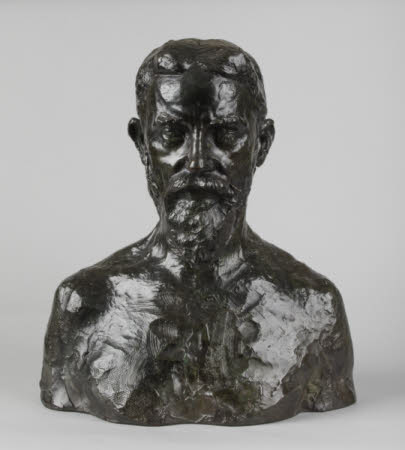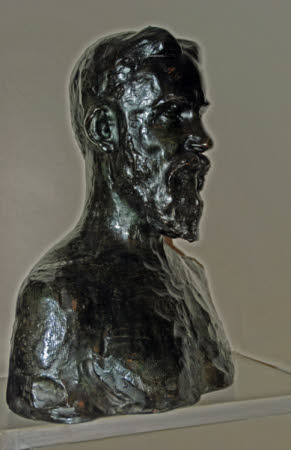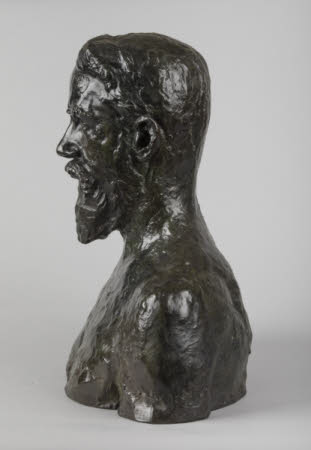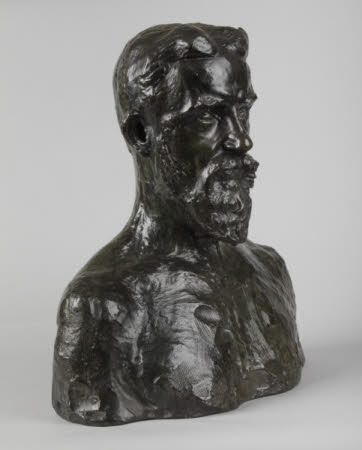George Bernard Shaw
Auguste Rodin (Paris 1840 – Meudon 1917)
Category
Art / Sculpture
Date
1906
Materials
Bronze
Measurements
521 x 432 x 260 mm
Place of origin
Paris
Order this imageCollection
Shaw's Corner, Hertfordshire
NT 1274943
Caption
In 1906 the renowned French sculptor Auguste Rodin (1840–1917) was commissioned to make a bust of the playwright, critic and philosopher George Bernard Shaw (1856–1950) by Shaw’s wife Charlotte (1857–1943). Two versions were ordered, one in bronze and one in marble. The bronze bust was transferred to the Shaw house, Shaw’s Corner in Hertfordshire, in 1945, after the property was gifted to the National Trust. Shaw had great respect bordering on veneration for Rodin’s skill as a sculptor, considering him to be a modern-day Michelangelo. After donating his home to the National Trust, he joked that Rodin’s bust would be remembered 1,000 years hence, while its subject would be ‘otherwise unknown’. The bronze sculpture accurately depicts Shaw’s appearance, while also suggesting the vitality of his presence.
Summary
Bronze, George Bernard Shaw (1856-1950) by Auguste Rodin (1840-1917), 1906. A head and shoulders portrait bust of Shaw aged 49, showing the playwright with characteristic full beard and hair parted at the centre. He faces forward and is depicted unclothed. Signed reverse, bottom left, A. Rodin.
Full description
The pioneering French sculptor Auguste Rodin created his head and shoulders bronze portrait bust of playwright and critic George Bernard Shaw in 1906. Shaw sat for Rodin at his studio at Meudon, near Paris. Shaw had first met Rodin in 1904, at a banquet held in London to welcome the famous French sculptor as the new president of the International Society of Sculptors, Painters and Gravers. In March 1906 Rodin was invited to tea with the Shaws at their London flat at Adelphi Terrace by Shaw’s wife Charlotte, and the idea of Rodin sculpting the famous playwright was discussed. In an influential article on Rodin published in The Nation in 1912, Shaw made clear his admiration for Rodin: ‘In the year 1906 it was proposed to furnish the world with an authentic portrait-bust of me before I had left the prime of life too far behind. The question then arose: Could Rodin be induced to undertake the work? On no other condition would I sit, because it was clear to me that Rodin was not only the greatest sculptor then living, but the greatest sculptor of his epoch: one of those extraordinary persons who, like Michael Angelo [sic], or Phidias, or Praxiteles, dominate whole ages…’ (Shaw 1912 [1932]). Two busts of Shaw were eventually commissioned, in bronze and marble, paid for by Charlotte. Rodin wrote to her the following month: ‘permit me to indicate that the price of a portrait (bust) in bronze is set at 20,000 francs; of marble at 25,000 francs.’ He confirmed receipt of a cheque for £1000, and the Shaws departed for Paris. The sittings took place at Meudon over a three-week period from April 16 to May 8 1906. It was the start of an important friendship which lasted until Rodin’s death in 1917. Shaw described the sittings in his article of 1912, providing a fascinating glimpse of Rodin’s techniques: ‘He plodded along exactly as if he were a river-god doing a job of wall-building in a garden for three or four francs a day. When he was in doubt he measured me with an old iron dividers, and then measured the bust. If the bust’s nose was too long, he sliced a bit out of it, and jammed the tip of it up to close the gap, with no more emotion or affectation than a glazier putting in a window pane. If the ear was in the wrong place, he cut it off and slapped it into its right place, excusing these ruthless mutilations to my wife (who half expected to see the already terribly animated clay bleed) by remarking that it was shorter than to make a new ear. Yet a succession of miracles took place as he worked… It was a process for the embryologist to study, not the aesthete. Rodin’s hand worked, not as a sculptor’s hand works, but as the Life Force works.’ (Shaw 1912 [1932], p.229). Many of Shaw’s friends visited Meudon to observe Rodin creating the clay bust in 1906, including Sydney Cockerell, William Rothenstein, and G.K. Chesterton. The American photographer Alvin Langdon Coburn was also present, and he accompanied the Shaws to witness the unveiling of Rodin’s statue The Thinker at this time. Three days later Shaw humorously assumed the pose of The Thinker in a photograph by Coburn. Shaw himself took experimental photographs of his sculpture (especially the Rodin plaster bust) reflecting a lifelong obsession with self-image. Rodin did not personally work on the casting and finishing in bronze, as he employed artisans to do the foundry work for him. From the plaster casts various moulds were made to be used in the bronze-casting process. The final mould would then be broken to release the bronze sculpture. The Alexis Rudier foundry cast Rodin’s work from 1902 until its closure in 1953, and the foundrymen would inscribe Rodin’s signature into the bronze cast. The bronze bust of Shaw by Rodin was cast by the foundry in the summer of 1906 and delivered to the Shaws’ London flat in October of that year. Here it was given pride of place on top of the bureau in the drawing room (seen in a photograph by Shaw taken around 1910; NT 1715309.119). The Shaws kept a plaster copy of the bust, a gift from Rodin, at Shaw’s Corner (NT 1275324). Shaw was delighted with the bust, writing to his French translator Augustin Hamon ‘[Rodin’s] bust of me - I have received the bronze – is a chef d’oeuvre.’ (Collected Letters, vol.2, p.665). To him the sculpture was so lifelike it blurred the boundaries between life and art: the piece became: ‘the living head of which I carried the model on my shoulders.’ (Shaw 1912 [1932], p.229). Shaw then commissioned Coburn to take photographs of the bust, which were subsequently employed as frontispiece portraits in his published works and represented Shaw in Shavian biographies (by Holbrook Jackson in 1908; and Henderson in 1911). Shaw urged his readers to look at the bust: ‘you will not find it a bit like that brilliant fiction known as G.B.S. or Bernard Shaw. But it is most frightfully like me… [Rodin] saw me. Nobody else has done that yet.' Certain Shavian characteristics were emphasized too, with the hair parting in the centre prompting one viewer to make comparisons with Michelangelo’s statue of Moses. This delighted Shaw (who adored Michelangelo’s work) and he wrote to the actress Lillah McCarthy ‘Rodin writes that the bust is a success – that people divine my character from it and call me “a young Moses”!!! Justice at last – from a Frenchman, of course.’ There was also an air of Mephistopheles about the bust. Rodin was reported to have said to Shaw: ‘Do you know, you look like – like the devil!’ And Shaw replied with a smile ‘But I am the devil!’ Rodin asked for the bronze bust of Shaw to be included in the 1907 Seventh Exhibition of the International Society of Sculptors, Painters and Gravers, alongside pieces commissioned by other British collectors of his work. Shaw consented willingly. He later loaned the bronze bust for other exhibitions, such as the Royal Glasgow Institute of the Fine Arts’ fifty-second Annual Exhibition in 1913. Lawrence Scobie, acting secretary for the Institute, wrote to thank Shaw: ‘The Council... are very glad to learn from Mr. John Lavery that you have consented to lend the bronze bust of yourself by Rodin for our forthcoming Exhibition.’ (British Library Add. MS 50516, ff.342-43). In 1931 Shaw loaned the bust again to the Rodin Exhibition held by the Leicester Galleries in London. On this occasion, he wrote a short preface to the catalogue which included the following statement: ‘[Rodin] won immortality for me, as the biographical dictionaries 1000 years hence would all contain an item – “Shaw, George Bernard, subject of a bust by Rodin: otherwise unknown.”’ Rodin later adapted the model of the Shaw bust conceived during the 1906 sitting, creating a small head to be reproduced in bronze. In 1914 Shaw had granted Rodin permission to make copies of the bust: ‘have as many replicas cast as you like: the work belongs to you, the honour to me: I am still proud to be known as your model; you are the only man before whom I feel genuinely humble.’ A total of fourteen casts were made of the small head, and the Shaws acquired one of the first six cast by the Alexis Rudier foundry between 1914 and 1934. The piece appears in photographs taken by Shaw and was donated by him to the Royal Academy of Dramatic Art (RADA) in 1945, to sit opposite a bust of Shakespeare. A number of other bronze small heads are known (Musee Rodin; Philadelphia Museum of Art); and another head and shoulders bust in bronze is in a private collection. Shaw generously donated the marble version of the Rodin bust to Hugh Lane, who founded the Municipal Gallery of Modern Art in 1908 (now The Hugh Lane, Dublin City Gallery). When presenting the gift, he wrote to Lane: ‘I had much rather the bust were under your care in the quite extraordinarily good collection you have founded in my native city, than hidden in a private house which already possesses an even more cherished masterpiece in the bronze cast taken from the original plaster.’ (Collected Letters, vol.2, p.811). Rodin’s permission was obtained, and Shaw donated the marble bust to Lane’s gallery in October 1908. (Lambert, 249). The Rodin bronze bust was kept in London until 1945, at which point Shaw brought it to Shaw’s Corner, preparing for the time when the house would become a museum in the care of the National Trust. The playwright believed that ‘busts outlive plays’, and consequently he gave the bust a commemorative role. In 1946 when Shaw invited the press to celebrate his 90th birthday, photographs of the bronze version of the bust took centre stage and were published in The Illustrated London News. (27 July 1946, p.87). Shaw took pleasure in posing with the bust, and the images were carefully selected to showcase his special relationship with sculpture. Alice McEwan 2020
Provenance
Purchased by Bernard and Charlotte Shaw from Rodin in 1906; thence among Shaw's possessions at the Shaws’ London residences until 1945 when brought to Shaw’s Corner; bequeathed with house and contents to the National Trust by George Bernard Shaw in 1950, together with Shaw's photographic archive.
Credit line
National Trust Collections (Shaw’s Corner, The George Bernard Shaw Collection)
Marks and inscriptions
Reverse, bottom left: Signed 'A. Rodin'
Makers and roles
Auguste Rodin (Paris 1840 – Meudon 1917), sculptor
References
Shaw, 1912 [1932]: Bernard Shaw, ‘Rodin’, The Nation, 9 November 1912. Reprinted in Pen Portraits and Reviews. London: Constable, 1932, pp. 226-31. National Book League (Great Britain), Bernard Shaw:, 1946?, p.38 Descharnes and Chabrun 1967: Robert Descharnes and Jean-François Chabrun, Auguste Rodin, trans. Edita Lausanne, London 1967 Shaw, 1972: George Bernard Shaw, Bernard Shaw Collected Letters 1898-1910, volume 2. (Ed.) Dan H. Laurence. London: Max Reinhardt, 1972 Lampert 1986: Catherine Lampert, Rodin, Sculpture & Drawings, London 1986









